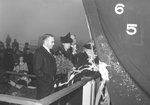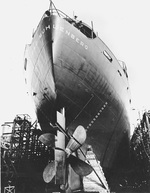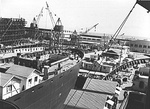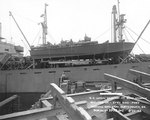Liberty-class Merchant Vessel
| Country | United States |
| Launched | 27 Sep 1941 |
| Displacement | 7,176 tons standard; 14,245 tons full |
| Length | 441 feet |
| Beam | 57 feet |
| Draft | 28 feet |
| Machinery | Three-cylinder reciprocating steam engine, two oil boilers, one screw |
| Power Output | 2,500 shaft horsepower |
| Speed | 11 knots |
| Range | 23,000nm |
| Crew | 62 |
| Armament | 1x4in or 1x5in stern gun, optional anti-aircraft weaponry such as 3in bow gun, 37mm bow guns, or 20mm machine guns |
| Cargo Capacity | 9,140 tons |
Contributor: C. Peter Chen
This article refers to the entire Liberty-class; it is not about an individual vessel.
ww2dbaseThe Merchant Marine Act, passed by the United States Congress in 1936, established the United States Maritime Commission that supervised the construction of an US Merchant Marine fleet that served in the civilian capacity during peaceful times but could easily convert to military transport use in times of war. Federal subsidies for the construction and operation of Merchant Marine vessels were also established. The size of the Merchant Marine was 50 in 1936, but was increased to 200 by 1940. The high war time demand for steam turbines, however, limited the construction of these ships, thus limiting the result that the Merchant Marine Act was meant to achieve. In 1940, Britain ordered 60 Ocean-class tramp steamships from American civilian shipyards to replace war losses. The design was simple and easy to build, with a coal-burning powerplant. The first Ocean-class ship, Ocean Vanguard, was launched on 16 Aug 1941. Very soon, the design was modified to conform to American construction practices in order to increase production efficiency. Namely, riveting methods were changed to save significant labor costs. To further increase efficiency, a new method of construction was invented: the ships were to be built in modularized sections, and they would be put together by welding instead of rivets. The resulting ship looked unconventional, or even ugly by some standards; after seeing the design, Franklin Roosevelt commented that "I think this ship will do us very well", but also described her as a useful ship that was a "real ugly duckling." The first 14 of these ships, now categorized as the Liberty-class, launched according to schedule on 27 Sep 1941. That date was promptly celebrated as the Liberty Fleet Day. The first of the 14 Liberty Ships was SS Patrick Henry. Henry, the American Revolutionary War hero who famously declared "give me liberty, or give me death", was among the reasons for the name of the class.
ww2dbaseIn the earlier days of the construction, it took about 230 days to build a Liberty Ship. Already impressive, construction time was actually reduced to an average of 42 days. The record for Liberty Ship construction was held by the building of SS Robert E. Peary, which was launched 4 days, 15 hours, and 30 minutes after the keel was laid, although this record was by far the exception; much of the fitting-out work remained to be done after launching, and expectedly no other Liberty Ship came close to this record. By 1943, three Liberty Ships were being launched every day.
ww2dbaseBetween 1941 and 1945, the following 18 shipyards in the United States built Liberty Ships:
- Alabama Drydock and Shipbuilding, Mobile, Alabama
- Bethlehem-Fairfield Shipyard, Baltimore, Maryland
- California Shipbuilding Corp., Los Angeles, California
- Delta Shipbuilding Corp., New Orleans, Louisiana
- J. A. Jones, Panama City, Florida
- J. A. Jones, Brunswick, Georgia
- Kaiser Company, Vancouver, Washington
- Marinship, Sausalito, California
- New England Shipbuilding East Yard and West Yard, South Portland, Maine (subsidiaries of Bath Iron Works)
- North Carolina Shipbuilding Company, Wilmington, North Carolina
- Oregon Shipbuilding Corporation, Portland, Oregon
- Richmond Shipyards, Richmond, California (subsidiary of Kaiser Shipyards)
- St. Johns River Shipbuilding, Jacksonville, Florida
- Southeastern Shipbuilding, Savannah, Georgia
- Todd Houston Shipbuilding, Houston, Texas
- Walsh-Kaiser Co., Inc., Providence, Rhode Island
ww2dbaseEarly Liberty Ships suffered hull and deck cracks, some of which led to fatal sinkings; for example, on 24 Nov 1943, SS John P. Gaines broke in half and sank, taking 10 men with her. The blame originally was on the new welding method and the careless haste to build large quantities of ships, but Constance Tipper of Cambridge University in England, Britain found out that it was actually the cold temperatures of the North Atlantic that made the steel brittle, leading to cracking in some instances. Welding still had a role in it, however, as welding allowed small cracks to grow longer over time (something riveting would prevent), just that it was not the primary reason. Structural reinforcements were added to Liberty Ships later to remedy this problem.
ww2dbaseBecause Liberty Ships were deployed by the British before the Americans entered the war, and also because there were so many of them in use, there were many trivia items associated with them. For example, SS Stephen Hopkins was the first American ship to sink a German naval vessel, the merchant raider Stier.
ww2dbaseWhile Liberty Ships symbolized wartime American industrial power, they also served the war in a practical sense: a single Liberty Ship could carry 2,840 jeeps, 440 tanks, or 230 million rounds of rifle ammunition. Each Liberty Ship was manned by a crew sized between 38 and 62; the crews were complimented by 21 to 40 US Navy personnel who operated the communications systems and weapons.
ww2dbaseThe last Liberty Ship built was SS Albert M. Boe, which was launched on 26 Sep 1945 and delivered on 30 Oct 1945. During the design's production life, 2,751 vessels were built; about 200 of them were lost during the war to various reasons. Many Liberty Ships remained in use in the United States, serving with the military during the Korean War as well as in civilian capacities. In the late-1960s, three Liberty Ships participated in US Navy radar research. As of 2005, two Liberty Ships remained operational; both museum ships, SS John W. Brown and SS Jeremiah O'Brien both sail regularly.
ww2dbaseSources: American Merchant Marine at War, United States National Park Service, Wikipedia.
Last Major Revision: Oct 2007
Liberty-class Merchant Vessel Interactive Map
Photographs
 |  |  |  |
Liberty-class Merchant Vessel Operational Timeline
| 19 May 1941 | Henry Kaiser’s Oregon Shipbuilding Corporation shipyard laid down its first keel in Way #8. The ship would go on to become Liberty-ship Meriwether Lewis (of Lewis and Clark fame). |
| 24 May 1941 | Bechtel-McCone’s California Shipbuilding yard at Terminal Island (CalShip) laid down its first keel. The ship would go on to become the Liberty-ship John C Fremont. |
| 27 Sep 1941 | 14 Liberty Ships were launched in the United States; they were to be transferred to the United Kingdom via the Lend-Lease program. |
| 2 Jan 1942 | The keel of Stephen Hopkins was laid down by the Kaiser Richmond Shipyards in Yard No. 2, Way #3 in Richmond, California, United States. |
| 14 Apr 1942 | Stephen Hopkins was launched at the Kaiser Richmond Shipyards at Yard No. 2 in Richmond, California, United States. |
| 15 Apr 1942 | Henry Kaiser’s Vancouver Shipyard laid down its first keel. The ship would go on to become the Liberty-ship George Vancouver. |
| 15 May 1942 | The first of the 489 Liberty Ships built at the Kaiser Richmond Shipyards was laid down in Shipyard No. 1. The ship was delivered 97 days later as the SS Edward Rowland Sill and served until 1967. |
| 27 Jun 1942 | The keel was laid for Liberty ship William A. Richardson at the Marinship yard. This was the first keel laid at Marinship and it was laid a mere 3 months after the W.A. Bechtel Corporation was awarded the shipyard contract from the Maritime Commission. |
| 19 Sep 1942 | Stephen Hopkins departed Cape Town, South Africa in ballast for Dutch Guiana. |
| 20 Sep 1942 | As of this date, American Liberty ship production exceeded the rate of sinkings. |
| 27 Sep 1942 | German auxiliary cruiser Stier and supply ship Tannenfels came across US liberty ship Stephen Hopkins off of Dutch Guiana. Exchanging gunfire at the distance of 2 miles starting at about 0900 hours, Stephen Hopkins sank about an hour later; only 15 men survived, and they drifted for a month before reaching the Brazilian coast. Stier, fatally damaged, was scuttled by her crew at 1140 hours; 2 men were lost. |
| 12 Apr 1943 | The keel of George Washington Carver was laid down at Yard No. 1 of Kaiser Richmond Shipyards, Richmond, California, United States. |
| 7 May 1943 | George Washington Carver was launched at Yard No. 1 of Kaiser Richmond Shipyards, Richmond, California, United States, sponsored by actress and civil rights activist Lena Horne. |
| 24 May 1943 | George Washington Carver was delivered to the United States Maritime Commission. |
| 16 Jun 1943 | The keel was laid for Liberty ship Jack London at the Marinship yard. This was the last Liberty ship made at Marinship as production had entirely shifted to building tankers, the ship type Marinship was created to build. |
| 26 Jul 1943 | The keel of Antoine Saugrain was laid down at Yard No. 2, Kaiser Richmond Shipyards, Richmond, California, United States. |
| 15 Aug 1943 | SS Antoine Saugrain was launched at Yard No. 2, Kaiser Richmond Shipyards, Richmond, California, United States. |
| 28 Aug 1943 | SS Antoine Saugrain was transferred to the United States War Shipping Administration. |
| 6 Nov 1943 | George Washington Carver arrived at Hampton Roads, Virginia, United States. |
| 23 Nov 1943 | George Washington Carver was transferred to the US Army. |
| 14 Jul 1944 | The last of 489 Liberty-ships built at the Kaiser Richmond Shipyards, the Benjamin Warner, was delivered to the Navy after 18 days on the ways and 13 days on the water being fitted out. |
| 17 Jul 1944 | The Liberty ship A. E. Bryan exploded whilst loading ammunition and explosives at Port Chicago, California, United States, taking with her the Victory ship Quinalt Victory berthed nearby. Ninety-seven men on the two ships were vapourised and even a 12 ton locomotive on the dockside vanished without trace. In total, 320 men were killed and 390 injured. More than 200 of the dead were black sailors being used as loaders. Later many sailors refused to work until safety was improved. Fifty were court martialed, convicted of mutiny and jailed. A public outcry led to their release but they were still deprived of all veteran's benefits for the rest of their lives. The last surviving "mutineer" Freddy Meeks was finally pardoned by President Bill Clinton in 1999. Four years later he died, aged 83. |
| 5 Dec 1944 | SS Antoine Saugrain was rendered dead in the water after being struck by two aerial torpedoes in Philippine waters. The ship claimed to have shot down several Japanese aircraft. She was carrying 450 passengers and crew; some were wounded during the attack, but all would eventually be accounted for after all survivors were rescued. |
| 6 Dec 1944 | SS Antoine Saugrain, damaged by two Japanese aerial torpedoes on the previous day, sank while under tow in the Surigao Strait in Philippine waters. |
| 30 Oct 1945 | Liberty Ship Albert M. Boe was delivered to the US Navy; she was to be the last Liberty Ship to be built. |
| 21 Mar 1947 | George Washington Carver entered the National Defense Reserve Fleet at Suisun Bay, California, United States. |
| 9 Jan 1964 | George Washington Carver was sold to First Steel & Ship Corp. for scrapping. |
Did you enjoy this article or find this article helpful? If so, please consider supporting us on Patreon. Even $1 per month will go a long way! Thank you. Share this article with your friends: Stay updated with WW2DB: |
Visitor Submitted Comments
17 Nov 2011 10:24:24 AM
I found the official log of S.S. Hammond. complete with crew lists and exact location of each enemy attack on ship. My Grandfather was the ship Dr. and apparent record keeper. also have all crew members war info and next of kin in case anybodys looking...
3 Mar 2012 12:20:38 PM
Hi,
How do I find the schedules & routes for Liberty Ships traveling from U.S. to Africa - August 1943 to Dec 1943.
My Dad was a passenger on one of those ships. I am in process of tracing his path.
Can you help?
Ken Coburn
10 May 2012 05:36:50 PM
my father was a 20mm gunner on the john m. moorehead and the s.s. jackson he saw action in the anzio beachhead ;southern france invasion ' and the battle of okinawa.i was wondering what ever happened to these ships?
28 Jul 2012 04:47:05 PM
Hello,
I'm looking for a photo of the S.S. JOHN GALLUP ( LIBERTY SHIP )
Thanks.
29 Aug 2012 11:54:00 PM
Hello,
My name is Jerry Wright and I enjoyed your web site, especially Brandi's from November 17, 2011.
I would love to ask her more questions as I am currently working on my dads Merchant Marine history.
My father served on the SS A.B. Hammond in WWII.
I am very interested in getting more info if at all possible
I really enjoyed your web site, thank you.
Please contact me, my E-mail is 67Tempest@msn.com.
28 Dec 2012 02:32:53 PM
My mom told me I had an uncle from the midwest named (last name BIERCE ) who was a suvivor from the SS John P. Gains that broke in two and sunk in the N. Pacific. Ten souls were lost but he survived in a raft for 3 days. Can anyone out there confirm via ship manifest? I'd really like to know if he is still alive and where.
Thank you,
Rick Miller
21 Apr 2014 06:14:59 PM
My dad served in the US Navy during WWII. He was on two different liberty ships: Park Benjamin and J. Willard Gibbs (in Russia). Any idea where I may obtain a picture of either ship. Thanks. Maryann
15 Jul 2014 12:47:42 PM
Lee Penlack mentioned that his father served on the S.S. Jackson. I assume he is talking about the James Jackson, the third Liberty launched at the Southeastern yard in Savannah, Ga. James Jackson was a Revolutionary War hero, Gov. of Georgia and later a U.S. Senator, but he was best known as the "The Brawling Pigmy" because of the 23+ duels he fought. I interviewed 120 yard workers and mariners who built and sailed on the ships built in in Savannah for my book, "On The Swing Shift: Building Liberty Ships in Savannah", published by the Naval Institute Press in 2009.
18 Jul 2014 11:36:38 AM
My father served on the AB Hammond in WW2. Brandy wrote in nov 2011 that she had discovered information on the ships log and the crew. I am looking for any information on this ship in WW@
26 Oct 2014 11:11:23 PM
What was the type of tank that the Liberty ship able to load 440 of them?
5 Mar 2015 01:43:13 PM
My father was in the US Navy Armed Guard on Liberty Ships during WW2. I would love to find photos of the SS Ralph Izard and the SS John C Breckenridge. Tx
2 Feb 2016 08:16:24 AM
I served on the S.S. Harry kirby which was launched in January 1945. I would like a picture of the ship and a list of the Gun Crew (27 men I believe)
4 Aug 2016 05:03:58 PM
I built then sailed the SS Henry M Robert #2921 out of the Houston Shipyard, Houston, Texas. If anyone that sailed on that ship has any photos of that ship and/or crewmen, please contact me.
13 Feb 2017 02:24:20 PM
I have a picture of my dad on the SS john Gallup in 1945
3 Apr 2017 10:35:08 AM
My Father served on the Liberty Ship SS George E. Badger and SS Edmund F. Dickins. Desperately looking for a photo of either. Need it for a memorial plaque. Thank you!
22 Jan 2018 03:47:03 PM
My father was an ordinary seaman on the SS Horace Greeley #641 in WW2 in the Pacific. Looking for any info on that ship, especially about a collision with a British ship in Panay, Phillipines in 1945.
4 Feb 2018 04:49:30 AM
British Liberty ships, the Sams, identical to the US ones, had slightly smaller crew than those operated by the United Sates. The US-operated Arthur Middleton had 42 sailors (officers and crew) and 27 gunners; the George G. Meade 41 and 25, the Robert Gray 39 and 23, and the George Cleeve 41 and 28. The standard was probably 8 officers, 33 crewmen and 25 gunners. By contrast the British operated Samsouri sank with 39 total crew and 10 gunners and the Samsuva had 37 and 20 gunners. The coal-fired ‘Oceans’ seemed to have had somewhat larger crews, around 48 crew and 10 gunners, while British ships manned by Lascars (sailors recruited from the Indian sub-continent) typically had crews twice the size of other British vessels.
David Edgerton: Britain’s War Machine’ (Penguin Books 2012)
13 Feb 2018 02:12:18 AM
The Liberty ship was devised initially by Robert Cyril Thompson, the son of a Sunderland shipbuilder, a public schoolboy who studied engineering at Cambridge university. He joined the family firm in 1930 and was appointed to the board a year later at the age of twenty-four. He led the development of a new kind of cheap ship for the depression years. Its new hull shape was tested at the National Physical Laboratory and it was equipped with a new and efficient reciprocating engine from the North-Eastern Marine Engineering Company. With British shipyards fully committed to war work, Thompson took his designs to the United States in 1941 where there was more available facilities and manpower for the vessels’ manufacture.
5 Apr 2018 07:30:01 PM
Does anyone have info about the Cape Newenham, a troop ship destined for the invasion of the Phillipenes in 1944 and was damaged and/or lost. My brother was aboard and survived but I'd like to know what became of the ship.
15 May 2018 06:39:21 PM
my father served on the john d morehead & the Helen hunt Jackson as a 20mm gunner. what ever happened to these ships/
12 Nov 2018 11:34:21 AM
The morehead was Sold private 1947, scrapped 1966 and the hunt was scrapped 1971 ....https://en.wikipedia.org/wiki/List_of_Liberty_ships
16 Mar 2023 01:21:21 PM
I am looking for crew members who served on the SS Martin Behrman, a Liberty Ship that ran from 1944 to 1965. Names, stories... Thank you in advance.
22 Apr 2023 01:36:03 PM
my father, gordon dickinson, worked on the ss amos kendall, the ss joseph g. cannon, the ss sea partridge and the ss phillip kearny. i'm writing his history and would be interested in any info about time on these ships. 1943,44,45.
All visitor submitted comments are opinions of those making the submissions and do not reflect views of WW2DB.
» Antoine Saugrain
» George Washington Carver
» Stephen Hopkins
- » 1,150 biographies
- » 337 events
- » 43,917 timeline entries
- » 1,241 ships
- » 350 aircraft models
- » 207 vehicle models
- » 374 weapon models
- » 123 historical documents
- » 260 facilities
- » 470 book reviews
- » 28,544 photos
- » 432 maps
Lt. Gen. Lewis B. "Chesty" Puller, at Guadalcanal
Please consider supporting us on Patreon. Even $1 a month will go a long way. Thank you!
Or, please support us by purchasing some WW2DB merchandise at TeeSpring, Thank you!
7 Oct 2007 05:46:12 PM
My grandfather built liberty ships in Jacksonville. I have a couple of pictures of the work crews. He operated a cutting torch. Does anybody else have pictures from the Jacksonville shipyard?